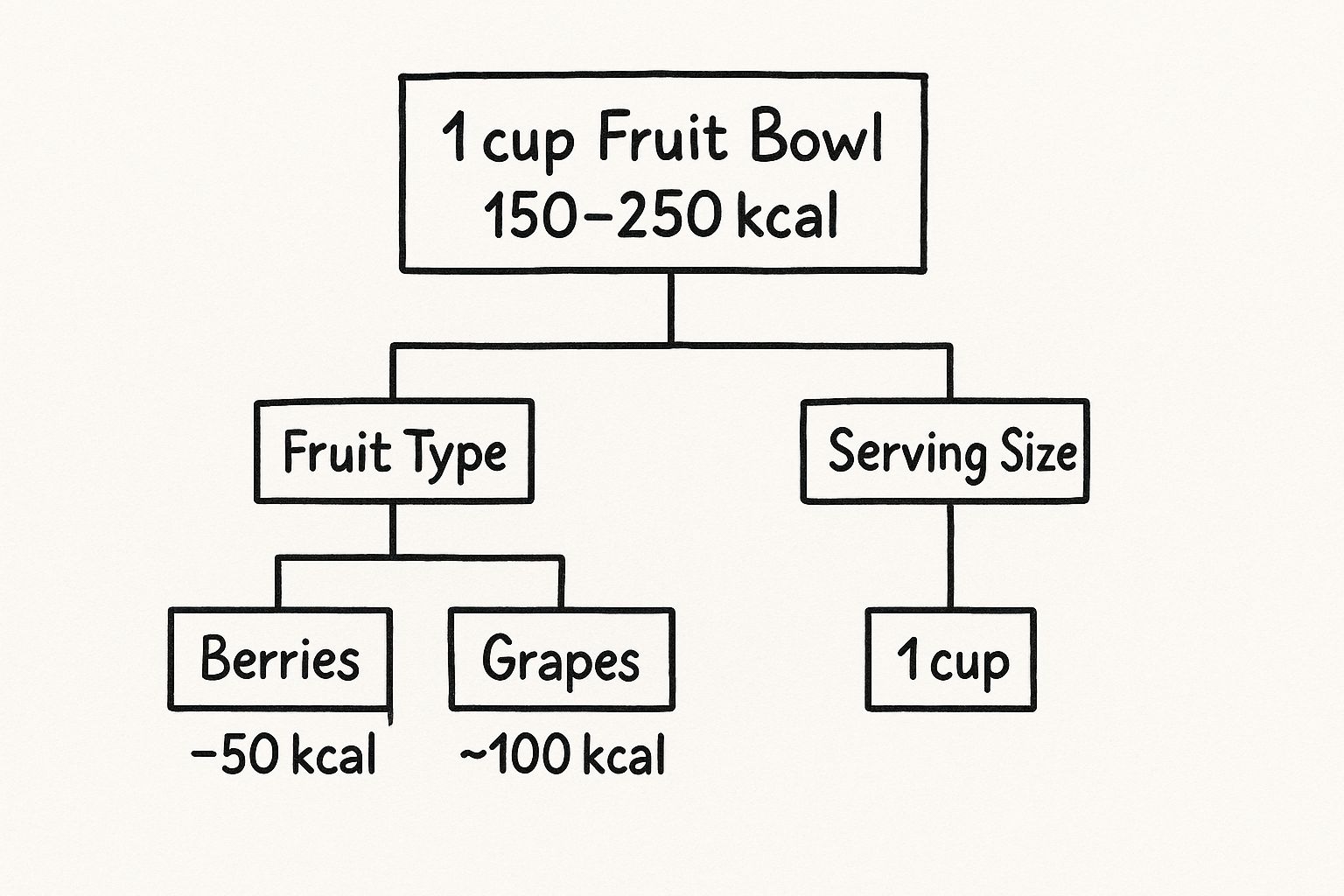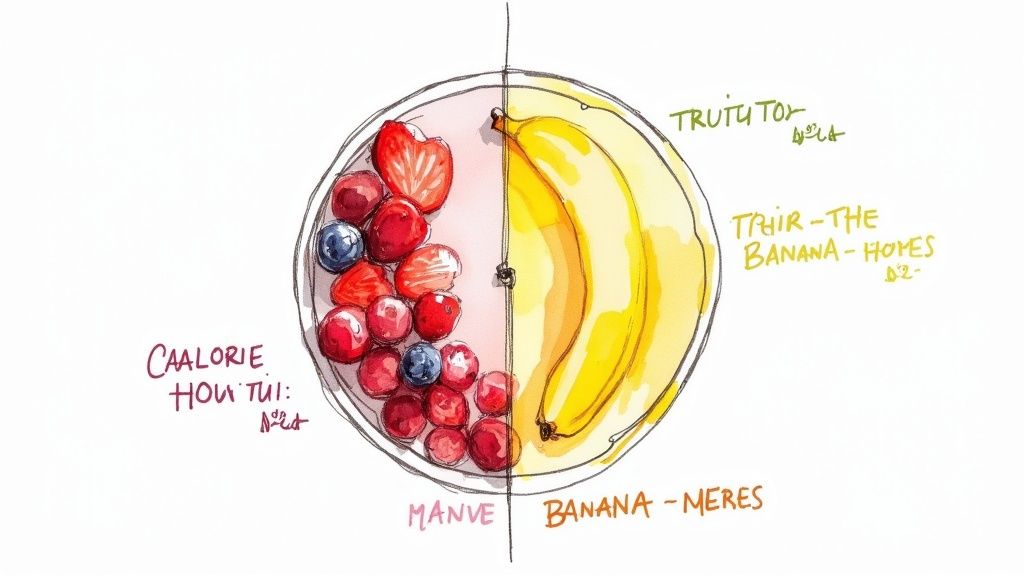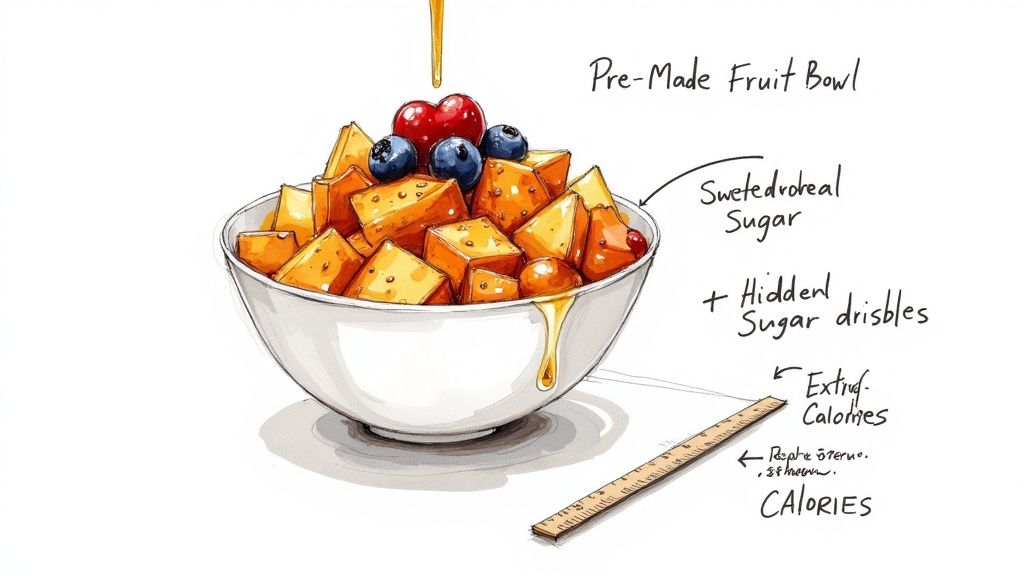How Many Calories Are In a Fruit Bowl? (It's Simpler Than You Think)
Curious about the calories in a fruit bowl? Learn how to build a healthy bowl, spot hidden sugars, and track nutrition without the stress.
Posted by
Let's cut right to the chase. A standard one-cup fruit bowl, the kind you’d get with mixed berries, melon, and a few grapes, typically lands somewhere between 150 and 250 calories. Of course, the final count hinges on what's inside and how much you pile in, but that’s a great starting point.
Your Quick Guide to Fruit Bowl Calories
Figuring out the calories in your fruit bowl doesn't need to feel like a math test. Think of it more like getting to know the energy packed into a snack that’s both delicious and good for you. Whether you're making one at home or grabbing it on the go, a little awareness goes a long way.
The two main things that will move the needle on your calorie count are the types of fruit you choose and your portion size. Fruits like bananas and mangoes are naturally higher in sugar and calories, making them more energy-dense. On the flip side, watery fruits like watermelon and strawberries are lighter and have fewer calories per bite.
A simple one-cup serving filled with common fruits like apples, oranges, and berries will almost always fall squarely in that 150 to 250 calorie window. For a deeper dive, you can explore more fruit nutrition insights to see how different choices compare.
Key Factors at a Glance
This quick visual shows just how much the type of fruit and serving size can alter the final calorie count of your bowl.

As you can see, even with the same one-cup portion, swapping out higher-calorie fruits like grapes for lower-calorie options like berries makes a real difference.
This is exactly why casual tracking is so helpful. You don't have to get out a food scale for every single grape. Just understanding these general estimates helps you make smarter choices in the moment. And for those times you want a quick record, you can just tell Munchlog.ai, "I had a bowl of fruit with berries and grapes," and let it figure out the details. It's about being aware, not obsessive.
A Quick Reference Table
To make things even easier, here's a handy table with some common fruit bowl ingredients. Think of it as your cheat sheet for building a bowl that fits your day.
Quick Calorie Guide for Common Fruit Bowl Ingredients (per cup)
| Fruit | Calories (approx.) | Carbs (g) | Protein (g) | Fat (g) |
|---|---|---|---|---|
| Strawberries | 53 | 13 | 1 | 0.5 |
| Blueberries | 84 | 21 | 1 | 0.5 |
| Watermelon | 46 | 12 | 1 | 0.2 |
| Grapes | 104 | 27 | 1 | 0.2 |
| Banana (sliced) | 133 | 34 | 1.6 | 0.5 |
| Mango (diced) | 99 | 25 | 1.4 | 0.6 |
| Apple (chopped) | 65 | 17 | 0.3 | 0.2 |
Remember, these are just estimates! The exact numbers can vary a bit based on ripeness and size, but this gives you a fantastic starting point for understanding what you're eating.
How to Build Your Perfect Fruit Bowl

Think of building a fruit bowl as your chance to play chef. You get to mix and match your favorite ingredients to create something that’s not just tasty but also hits the exact nutritional notes you're aiming for. It's all about making smart choices that fit your vibe.
Your journey starts with the base. Not all fruits are created equal in the calorie department, and your choices here set the stage for the final count. For instance, something like dragon fruit is pretty light at just 60 calories per 100 grams. A banana, on the other hand, packs around 89 calories for the same amount because it's naturally higher in carbs. Staples like apples and oranges sit comfortably in the middle, making them fantastic, versatile options.
Choosing Your Fruit Base
So, what are you in the mood for? A light, refreshing snack, or something with more staying power to get you through a busy morning? The fruits you pick will make all the difference.
- For a Lower-Calorie Bowl: Go for fruits with high water and fiber content. We're talking berries, watermelon, cantaloupe, and strawberries. They fill you up without weighing you down. We dive deeper into their benefits in our guide to mixed berries nutrition facts.
- For a Higher-Energy Bowl: If you need a serious energy boost, especially before a workout, grab fruits that are more calorie-dense. Bananas, mangoes, grapes, and pineapple are all excellent choices that provide that extra fuel.
Adding the Extras (The Fun Part!)
Now for the best part—the toppings! This is where you can truly make the bowl your own. But it's good to be mindful, because this is also where a simple snack can quickly turn into a high-calorie meal if you're not paying attention.
Every topping you add shifts the nutritional balance. A handful of nuts brings in healthy fats, a dollop of yogurt amps up the protein, and a drizzle of honey will bump up the carbs.
Let's break down how a few common additions can change things up. Just two tablespoons of chia seeds, for example, will add about 110 calories but also a great hit of fiber and omega-3s. A scoop of plain Greek yogurt might add 50-60 calories but also gives you a satisfying 10-12 grams of protein, which helps keep you fuller for longer.
Calorie Impact of Common Fruit Bowl Toppings (per serving)
Toppings are fantastic for boosting flavor, texture, and nutrition, but it helps to know how they stack up. Here’s a quick look at how some popular choices affect your bowl's final numbers.
| Topping (Serving Size) | Calories Added (approx.) | Primary Macro Boost | Good For |
|---|---|---|---|
| Almonds (1/4 cup) | 170 | Fat, Protein | Sustained energy, crunch |
| Greek Yogurt (1/2 cup) | 60-80 | Protein | Satiety, creaminess |
| Granola (1/4 cup) | 100-120 | Carbs | Quick energy, texture |
| Chia Seeds (2 tbsp) | 110 | Fiber, Fat | Fullness, omega-3s |
| Honey (1 tbsp) | 64 | Carbs (Sugar) | Sweetness, quick fuel |
This isn't about getting obsessed with numbers; it's about awareness. A sprinkle of granola here and a scoop of yogurt there can add up.
You don't have to break out the food scale every time. Simply understanding that these extras have an impact is the most important step. When you're ready to track it, just tell an app like Munchlog.ai, "I had a fruit bowl with berries, yogurt, and granola," and let it do the heavy lifting. It's about easy tracking, not extra stress.
Spotting Hidden Calories in Pre-Made Bowls

Grabbing a fruit bowl from a café or juice bar feels like a smart, healthy move. And it often is! But the calories in a fruit bowl someone else makes can be worlds apart from the one you’d throw together at home. The main culprits are often hiding in plain sight.
First up, let's talk about portion distortion. A "large" fruit bowl from a shop might actually hold three or even four standard servings of fruit. While fruit is fantastic for you, that much can easily double or triple the calories you thought you were eating. A bigger bowl simply means more fruit, more natural sugars, and a higher calorie count.
Then there are the sneaky additions that can transform a light snack into a full-blown dessert. Many pre-made options, especially açai or smoothie bowls, are built on sweetened bases. These blends are frequently mixed with things like apple juice concentrate or agave to make them taste better, piling on calories you never even considered.
Common Calorie Traps to Watch For
The goal isn't to avoid these bowls entirely, but to become a smarter customer. Knowing what to look for helps you pick an option that actually fits your health goals. Here are a few things that can send the calorie count soaring:
- Sugary Syrups and Dressings: That drizzle of honey or maple syrup seems innocent enough, right? But a heavy-handed pour can easily add 60-100 calories in a flash. Some bowls even come with yogurt dressings that are loaded with added sugar.
- Candied Nuts and Sweetened Granola: Nuts are a great source of healthy fats, but candied versions are basically coated in sugar. In the same way, many store-bought granolas are packed with oils and sweeteners, turning a healthy topping into a high-calorie crunch.
- Dried Fruit Overload: A few dried cranberries can add a nice chewy texture, but it's incredibly easy to go overboard. Remember, dried fruit is a much more concentrated source of sugar and calories than fresh fruit.
It's all about awareness, not avoidance. A quick glance at the ingredients or simply asking how the bowl is made can give you all the info you need to make a mindful choice.
Also, be mindful of higher-calorie fruits like avocado, which can add a surprising number of calories to what seems like a light meal.
When you're unsure, just ask for dressings or sweeteners on the side. This one simple request puts you back in the driver's seat, giving you full control over the final calorie count.
And for those times you do grab a bowl on the go, tracking it is a breeze. Just tell Munchlog.ai, "I had a large açai bowl with granola and honey," and it'll handle the rest. You stay informed without sacrificing convenience.
How to Track Your Fruit Bowl in Seconds

You’ve just put together a beautiful fruit bowl—a mix of fresh berries, half a banana, and a sprinkle of granola. It looks incredible, but then the thought of logging it all hits you. Do you really have to stop, look up each ingredient, guess the amounts, and punch everything into some clunky app?
Nope. The old way of tracking calories was a chore, and frankly, it often sucked the joy right out of eating. This is where casual, voice-powered logging changes everything. It’s all about being mindful of the calories in a fruit bowl without getting bogged down in the details.
Instead of interrupting your meal with a food scale or a calculator, you can just eat. When you're done, you grab your phone and simply say what you had.
Logging a Meal in One Sentence
Picture this: you finish your delicious bowl and open up Munchlog.ai. Instead of typing, you just say, "I had a fruit bowl with strawberries, blueberries, half a banana, and some almond butter."
That’s literally all it takes. The AI gets to work instantly, estimating the calories and giving you a macro breakdown of carbs, protein, and fat. The point isn't clinical precision down to the last gram; it's about getting a solid nutritional snapshot with zero hassle. While weighing your food has its place, as we cover in our guide on how to weigh food for weight loss, it’s not always practical for a quick, everyday meal like this.
This whole approach flips food tracking on its head. You enjoy your food first, and the logging becomes a simple, two-second afterthought.
The goal is to make tracking feel as natural as talking. By removing the manual work, you can stay consistent with your goals without feeling like you're on a strict diet. It’s awareness, not obsession.
Munchlog.ai takes your voice entry and provides a clear, estimated breakdown. You get the key numbers you need—calories, macros—without being flooded with details that don't matter.
This kind of immediate feedback is incredibly powerful. You get a quick sense of your meal's nutritional value, which helps you make smarter choices throughout the rest of your day. It’s all about building sustainable habits, one conversation at a time.
The Bigger Picture of Fruit in Your Diet
https://www.youtube.com/embed/cJMJ3Mnu3d4
While it's smart to have a handle on the calories in your fruit bowl, it’s crucial to step back and see the full picture. Calories are just one small piece of a much bigger, more interesting story. A bowl of fruit is so much more than energy—it's a powerhouse of vitamins, minerals, and other amazing stuff your body loves.
Think of it like this: you're not just consuming calories, you're loading up on powerful nutrients. Every spoonful delivers a dose of dietary fiber, which is fantastic for keeping you feeling full and satisfied. This simple trick can make it a lot easier to sidestep those less healthy, high-calorie snacks, making it a win-win for anyone trying to manage their weight without feeling deprived.
More Than Just Numbers
If you only focus on calories, you risk missing the incredible health benefits packed into your food. A fruit bowl is the perfect example of nutrient density—it offers a massive wellness return on a relatively small calorie investment.
So, what are you really getting?
- Vitamins: Fruits are famously loaded with essentials like Vitamin C, which is a hero for your immune system and skin health.
- Antioxidants: Berries, in particular, are antioxidant superstars, helping your body fight off stress from the inside out.
- Hydration: Many fruits, like watermelon and strawberries, have a high water content, which is a delicious way to help you stay hydrated.
This change in focus is at the heart of mindful eating. Instead of slapping "good" or "bad" labels on food, you start to appreciate what it actually does for your body. It’s all about making informed choices, not following rigid, joyless diets. Of course, knowing your personal targets helps, and our guide on how to calculate your daily calorie needs is a great place to start.
Tying It All Together
It's also worth thinking about how different foods contribute to your overall well-being. For example, some fruits and fermented foods can play a role in understanding natural probiotics and gut health, which is a hot topic for a reason.
When you begin to appreciate the complete nutritional profile of your fruit bowl, it stops being just a snack. It becomes a proactive, powerful step toward a healthier and more mindful life.
A Few Common Questions About Fruit Bowl Calories
Even when you've got a handle on the basics, a few specific questions always seem to pop up when you're trying to figure out the calories in your fruit bowl. Let's tackle some of the most common ones with clear, practical answers you can use right away.
What Are the Best Low-Calorie Fruits to Use?
If you're aiming for a lighter bowl, your best friends are fruits with high water content. They help you build a big, satisfying portion without running up the calorie count.
Think about reaching for these first:
- Watermelon: It's a champion of hydration, coming in at only 46 calories per cup.
- Strawberries: You can pack a whole cup of sliced strawberries into your bowl for just over 50 calories.
- Cantaloupe: Another fantastic melon that offers about 54 calories per cup and a great dose of vitamins A and C.
These are perfect for creating a bowl that feels generous and indulgent but keeps the overall calories nice and low.
Is Frozen Fruit Just as Good as Fresh?
Yes, absolutely! Don't hesitate to reach for frozen fruit—it's an incredibly convenient and nutritious choice.
Most fruits are flash-frozen right after they're picked, which is when they're at their peak ripeness. This process does a fantastic job of locking in their vitamins and minerals. The nutritional difference between fresh and frozen is almost zero, so go with whatever is easiest and most affordable for you.
One quick tip: always glance at the ingredients list to make sure there are no added sugars. Some brands sweeten their frozen fruit blends, which can sneak in extra calories.
The bottom line is simple: fruit is fruit, whether it's fresh or frozen. The important thing is to get a good variety into your diet, so embrace the convenience!
How Do I Make My Fruit Bowl More Filling?
A fruit bowl on its own can sometimes leave you feeling hungry again pretty quickly. The secret to giving it real staying power is to add a source of protein and healthy fat. These two macros are digested more slowly, which is key to feeling satisfied for longer.
A dollop of plain Greek yogurt is a game-changer. It adds a delicious creamy texture, around 10-12 grams of protein, and only about 60 calories. You could also sprinkle on a tablespoon of chia seeds for extra fiber and healthy fats, or toss in a small handful of almonds for a great crunch.
These simple additions can transform your fruit bowl from a light snack into a much more balanced and substantial mini-meal.
Ready to track your custom fruit bowl without all the guesswork? munchlog.ai lets you log your meals just by speaking. Give it a try and see how easy mindful eating can be.